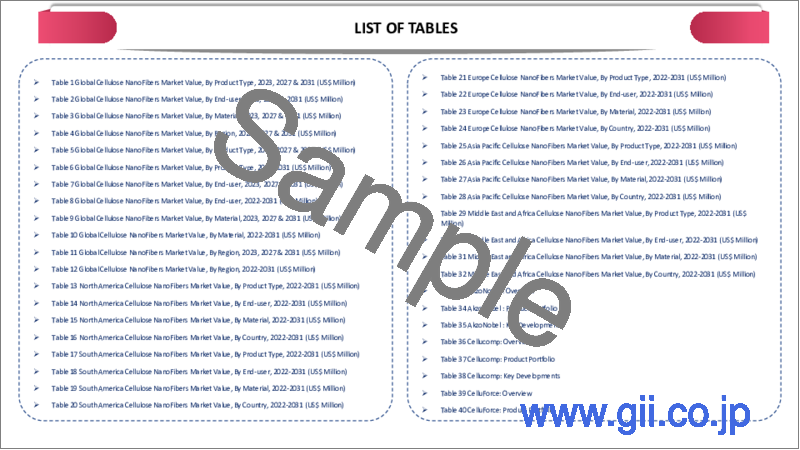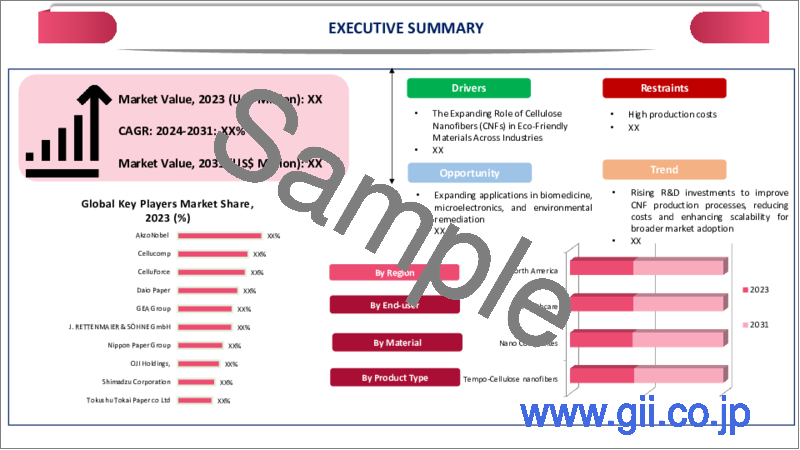|
|
市場調査レポート
商品コード
1542943
セルロースナノファイバーの世界市場:2024年~2031年Global Cellulose NanoFibers Market - 2024-2031 |
||||||
カスタマイズ可能
適宜更新あり
|
|||||||
| セルロースナノファイバーの世界市場:2024年~2031年 |
|
出版日: 2024年08月26日
発行: DataM Intelligence
ページ情報: 英文 186 Pages
納期: 即日から翌営業日
|
- 全表示
- 概要
- 目次
レポート概要
セルロースナノファイバーの世界市場は2023年に24億米ドルに達し、2031年には73億米ドルに達し、予測期間2024-2031年のCAGRは8.5%で成長すると予測される
セルロースナノファイバー(CNF)は、植物に豊富に含まれるポリマーであるセルロースから得られるナノ材料の一種です。直径5~50ナノメートルのこの繊維は、アスペクト比、強度、剛性が高く、さまざまな用途に有望です。機械的または化学的プロセスによって製造されるCNFは、再生可能な起源と顕著な機械的特性により、従来の材料に代わる持続可能な材料として、包装、複合材料、エレクトロニクス、生物医学分野などの産業で注目を集めています。
市場力学:
促進要因と抑制要因
持続可能な素材への需要の高まり
世界のセルロースナノファイバー(CNF)市場は、持続可能で環境に優しい素材に対する需要の高まりによって牽引されています。企業は、従来の素材に代わる環境負荷の低い素材を求めています。木材や農業残渣のような再生可能資源に由来するCNFは、生分解性と低カーボンフットプリントを提供します。自動車業界では、燃費を向上させ排出ガスを削減するために、軽量複合材料にCNFを組み込んでいます。このような環境に優しい材料へのシフトがCNF市場の成長を促進しています。
高い生産コスト
セルロースナノファイバー(CNF)市場は、高い製造コスト、複雑な製造工程、標準化された規制の欠如、エンドユーザーの限られた認識などの課題に直面しています。しかし、現在進行中の調査と技術の進歩により、これらの障壁が克服され、今後数年間でCNFの幅広い採用が見込まれます。
市場セグメンテーション
世界のセルロースナノファイバー市場は、製品タイプ、エンドユーザー、地域によって区分されます。
製品タイプ別ではテンポセルロースナノファイバーが約54.1%を占めています。TEMPO-セルロースナノファイバー(TEMPO-CNF)は、特性や機能性が強化されたセルロースナノファイバーの一種です。セルロースの一級水酸基を選択的に酸化する化学修飾プロセスであるTEMPO酸化によって製造されます。
この高電荷を帯びた個別化ナノファイバーは、直径が3~4ナノメートルと均一です。水や他の極性溶媒に非常に分散しやすく、透明フィルム、コーティング、ハイドロゲルの作成に理想的です。表面電荷の増加や機械的強度の向上など、そのユニークな特性は、パッケージング、エレクトロニクス、バイオメディカル分野での高性能用途に理想的です。
市場地域別シェア
北米は予測期間を通じて市場シェア全体の約38.4%を占めると予測されます。
北米は、再生可能資源を採用し、多くの用途でカーボンナノファイバーの利用を拡大するための政府イニシアティブの増加により、予測期間を通じて市場全体の約38.4%のシェアを占めると予測されます。
例えば、2024年7月、メイン大学の研究者は、静電接触脱水技術を開発することにより、包装材料としてのセルロースナノファイバーの商業的採用を合理化し、乾燥プロセスを高速化することを目指しています。
目次
第1章 調査手法と調査範囲
第2章 定義と概要
第3章 エグゼクティブサマリー
第4章 市場力学
- 影響要因
- 促進要因
- 持続可能な素材への需要の高まり
- ナノテクノロジーの進歩
- 抑制要因
- 高い生産コスト
- 機会
- 影響分析
- 促進要因
第5章 産業分析
- ポーターのファイブフォース分析
- サプライチェーン分析
- 価格分析
- 規制分析
- 特許分析
- PESTLE分析
- SWOT分析
- DMIオピニオン
第6章 製品タイプ別
- テンポセルロースナノファイバー
- カルボキシメチルセルロースナノファイバー
- その他
第7章 エンドユーザー別
- ナノコンポジット
- フィルター
- 食品包装
- 化粧品
- 電子機器
- ヘルスケア
- その他
第8章 地域別
- 北米
- 米国
- カナダ
- メキシコ
- 欧州
- ドイツ
- 英国
- フランス
- イタリア
- スペイン
- その他欧州
- 南米
- ブラジル
- アルゼンチン
- その他南米
- アジア太平洋
- 中国
- インド
- 日本
- 韓国
- その他アジア太平洋地域
- 中東・アフリカ
第9章 競合情勢
- 競合シナリオ
- 市況/シェア分析
- M&A分析
第10章 企業プロファイル
- GEA Group
- 会社概要
- 製品ポートフォリオと説明
- 財務概要
- 主な発展
- Nippon Paper Group
- OJI Holdings
- Daio Paper
- Cellucomp
- CelluForce
- Tokushu Tokai Paper co Ltd
- Rettenmaier
- AkzoNobel(*LIST NOT EXHAUSTIVE)
第11章 付録
Report Overview
Global Cellulose NanoFibers Market reached US$ 2.4 billion in 2023 and is expected to reach US$ 7.3 billion by 2031, growing at a CAGR of 8.5% during the forecast period 2024-2031
Cellulose nanofibers (CNFs) are a type of nanomaterial derived from cellulose, a plant-abundant polymer. These fibers, ranging from 5 to 50 nanometers in diameter, have high aspect ratio, strength, and stiffness, making them promising for various applications. Produced through mechanical or chemical processes, CNFs are gaining attention in industries like packaging, composites, electronics, and biomedical fields as a sustainable alternative to traditional materials due to their renewable origin and remarkable mechanical properties.
Market Dynamics: Drivers & Restraints
Growing demand for sustainable materials
The global cellulose nanofibers (CNFs) market is driven by the growing demand for sustainable and eco-friendly materials. Companies are seeking alternatives to traditional materials with lower environmental impact. CNFs, derived from renewable resources like wood and agricultural residues, offer biodegradability and lower carbon footprints. The automotive industry is incorporating CNFs into lightweight composite materials to improve fuel efficiency and reduce emissions. This shift towards greener materials is driving the growth of the CNF market.
High production costs
The cellulose nanofibers (CNFs) market faces challenges due to high production costs, complex manufacturing processes, lack of standardized regulations, and limited awareness among end-users. However, ongoing research and technological advancements are expected to overcome these barriers, leading to broader adoption of CNFs in the coming years.
Market Segment Analysis
The global cellulose nanofibers market is segmented based on product type, end-user, and region.
The tempo-cellulose nanofibers from the product type segment accounted for approximately 54.1% of the cellulose nanofibers market share
The tempo-cellulose nanofibers from the product type segment accounted for approximately 54.1%. TEMPO-cellulose nanofibers (TEMPO-CNFs) are a type of cellulose nanofiber with enhanced properties and functionalities. They are produced through TEMPO oxidation, a chemical modification process that selectively oxidizes the primary hydroxyl groups of cellulose.
These highly charged, individualized nanofibers have a uniform diameter of 3 to 4 nanometers. They are highly dispersible in water and other polar solvents, making them ideal for creating transparent films, coatings, and hydrogels. Their unique properties, including increased surface charge and improved mechanical strength, make them ideal for high-performance applications in packaging, electronics, and biomedical fields.
Market Geographical Share
North America is estimated to hold about 38.4% of the total market share throughout the forecast period
North America is estimated to hold about 38.4% of the total market share throughout the forecast period due to an increase in government initiatives to adopt renewable resources and to increase the utilization of carbon nanofibers in numerous applications.
For instance, in July 2024, researchers at the University of Maine aim to streamline the commercial adoption of cellulose nanofibers as a packaging material by developing an electrostatic contact dewatering technique, thus speeding up the drying process.
Market Segmentation
By Product Type
- Tempo-Cellulose nanofibers
- Carboxymethyl-cellulose Nanofibers
- Others
By End User
- Nano Composites
- Filters
- Food Packaging
- Cosmetics
- Electronic devices
- Healthcare
- Others
By Region
- North America
- The U.S.
- Canada
- Mexico
- Europe
- Germany
- UK
- France
- Italy
- Spain
- Rest of Europe
- South America
- Brazil
- Argentina
- Rest of South America
- Asia-Pacific
- China
- India
- Japan
- South Korea
- Rest of Asia-Pacific
- Middle East and Africa
Market Competitive Landscape
The major global players in the market include GEA Group, Nippon Paper Group, OJI Holdings, Daio Paper, Cellucomp, CelluForce, Tokushu Tokai Paper co Ltd, Rettenmaier, and Akzonobel among others.
Key Developments
- In May 2024, Kao Corporation launched LUNAFLOW RA, a mold release agent for use in smoothly removing rubber and resin products from molds during manufacture. LUNAFLOW RA is made using cellulose nanofibers (CNF), a cutting-edge biomass material, and features superior demolding performance and durability for repeated use once applied. The product can be expected to improve work efficiency in the manufacturing process, and is both solvent- and fluorine-free, making it friendly to both the workers and the environment.
Why Purchase the Report?
- To visualize the global cellulose nanofibers market segmentation based on product type, end-user, and region as well as understand key commercial assets and players.
- Identify commercial opportunities by analyzing trends and co-development.
- Excel data sheet with numerous data points of the cellulose nanofibers market level with all segments.
- PDF report consists of a comprehensive analysis after exhaustive qualitative interviews and an in-depth study.
- Product mapping available as excel consisting of key products of all the major players.
The global cellulose nanofibers market report would provide approximately 64 tables, 61 figures, and 186 pages.
Target Audience 2024
- Manufacturers/ Buyers
- Industry Investors/Investment Bankers
- Research Professionals
- Emerging Companies
Table of Contents
1. Methodology and Scope
- 1.1. Research Methodology
- 1.2. Research Objective and Scope of the Report
2. Definition and Overview
3. Executive Summary
- 3.1. Snippet by Product Type
- 3.2. Snippet by End User
- 3.3. Snippet by Region
4. Dynamics
- 4.1. Impacting Factors
- 4.1.1. Drivers
- 4.1.1.1. Growing demand for sustainable materials
- 4.1.1.2. Advancements in nanotechnology
- 4.1.2. Restraints
- 4.1.2.1. High production costs
- 4.1.3. Opportunity
- 4.1.4. Impact Analysis
- 4.1.1. Drivers
5. Industry Analysis
- 5.1. Porter's Five Force Analysis
- 5.2. Supply Chain Analysis
- 5.3. Pricing Analysis
- 5.4. Regulatory Analysis
- 5.5. Patent Analysis
- 5.6. PESTLE Analysis
- 5.7. SWOT Analysis
- 5.8. DMI Opinion
6. By Product Type
- 6.1. Introduction
- 6.1.1. Market Size Analysis and Y-o-Y Growth Analysis (%), By Product Type
- 6.1.2. Market Attractiveness Index, By Product Type
- 6.2. Tempo-Cellulose nanofibers*
- 6.2.1. Introduction
- 6.3. Carboxymethyl-cellulose Nanofibers
- 6.4. Others
7. By End User
- 7.1. Introduction
- 7.1.1. Market Size Analysis and Y-o-Y Growth Analysis (%), By End User
- 7.1.2. Market Attractiveness Index, By End User
- 7.2. Nano Composites*
- 7.2.1. Introduction
- 7.2.2. Market Size Analysis and Y-o-Y Growth Analysis (%)
- 7.3. Filters
- 7.4. Food Packaging
- 7.5. Cosmetics
- 7.6. Electronic devices
- 7.7. Healthcare
- 7.8. Others
8. By Region
- 8.1. Introduction
- 8.1.1. Market Size Analysis and Y-o-Y Growth Analysis (%), By Region
- 8.1.2. Market Attractiveness Index, By Region
- 8.2. North America
- 8.2.1. Introduction
- 8.2.2. Key Region-Specific Dynamics
- 8.2.3. Market Size Analysis and Y-o-Y Growth Analysis (%), By Product Type
- 8.2.4. Market Size Analysis and Y-o-Y Growth Analysis (%), By End User
- 8.2.5. Market Size Analysis and Y-o-Y Growth Analysis (%), By Country
- 8.2.5.1. The U.S.
- 8.2.5.2. Canada
- 8.2.5.3. Mexico
- 8.3. Europe
- 8.3.1. Introduction
- 8.3.2. Key Region-Specific Dynamics
- 8.3.3. Market Size Analysis and Y-o-Y Growth Analysis (%), By Product Type
- 8.3.4. Market Size Analysis and Y-o-Y Growth Analysis (%), By End User
- 8.3.5. Market Size Analysis and Y-o-Y Growth Analysis (%), By Country
- 8.3.5.1. Germany
- 8.3.5.2. UK
- 8.3.5.3. France
- 8.3.5.4. Italy
- 8.3.5.5. Spain
- 8.3.5.6. Rest of Europe
- 8.4. South America
- 8.4.1. Introduction
- 8.4.2. Key Region-Specific Dynamics
- 8.4.3. Market Size Analysis and Y-o-Y Growth Analysis (%), By Product Type
- 8.4.4. Market Size Analysis and Y-o-Y Growth Analysis (%), By End User
- 8.4.5. Market Size Analysis and Y-o-Y Growth Analysis (%), By Country
- 8.4.5.1. Brazil
- 8.4.5.2. Argentina
- 8.4.5.3. Rest of South America
- 8.5. Asia-Pacific
- 8.5.1. Introduction
- 8.5.2. Key Region-Specific Dynamics
- 8.5.3. Market Size Analysis and Y-o-Y Growth Analysis (%), By Product Type
- 8.5.4. Market Size Analysis and Y-o-Y Growth Analysis (%), By End User
- 8.5.5. Market Size Analysis and Y-o-Y Growth Analysis (%), By Country
- 8.5.5.1. China
- 8.5.5.2. India
- 8.5.5.3. Japan
- 8.5.5.4. South Korea
- 8.5.5.5. Rest of Asia-Pacific
- 8.6. Middle East and Africa
- 8.6.1. Introduction
- 8.6.2. Key Region-Specific Dynamics
- 8.6.3. Market Size Analysis and Y-o-Y Growth Analysis (%), By Product Type
- 8.6.4. Market Size Analysis and Y-o-Y Growth Analysis (%), By End User
9. Competitive Landscape
- 9.1. Competitive Scenario
- 9.2. Market Positioning/Share Analysis
- 9.3. Mergers and Acquisitions Analysis
10. Company Profiles
- 10.1. GEA Group*
- 10.1.1. Company Overview
- 10.1.2. Product Portfolio and Description
- 10.1.3. Financial Overview
- 10.1.4. Key Developments
- 10.2. Nippon Paper Group
- 10.3. OJI Holdings
- 10.4. Daio Paper
- 10.5. Cellucomp
- 10.6. CelluForce
- 10.7. Tokushu Tokai Paper co Ltd
- 10.8. Rettenmaier
- 10.9. AkzoNobel (*LIST NOT EXHAUSTIVE)
11. Appendix
- 11.1. About Us and Services
- 11.2. Contact Us






